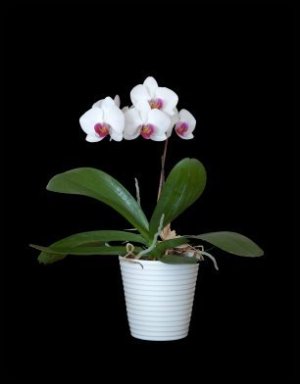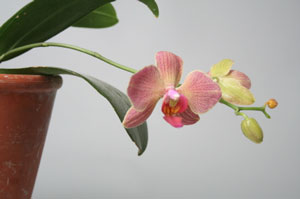 If you keep orchids, sooner or later they will need repotting. In most cases, repotting is necessary, not because the orchid has outgrown its container, but because the growing medium has started to decay and restrict the flow of air to the orchid's roots. In this scenario, the plant is usually repotted back into its original container with fresh growing medium. Occasionally a vigorous plant will simply outgrow its container and need to be moved to a larger pot. Repotting is also often the first step in nursing a sick or overwatered orchid back to health.
If you keep orchids, sooner or later they will need repotting. In most cases, repotting is necessary, not because the orchid has outgrown its container, but because the growing medium has started to decay and restrict the flow of air to the orchid's roots. In this scenario, the plant is usually repotted back into its original container with fresh growing medium. Occasionally a vigorous plant will simply outgrow its container and need to be moved to a larger pot. Repotting is also often the first step in nursing a sick or overwatered orchid back to health.
Sympodial: These types of orchids feature a stem, called a "rhizome," that grows horizontally across the growing medium, rooting as it goes along. Unless they are repotted into a larger container, the roots will eventually grow over the rim of the pot and dangle into thin air (hindering new growth). The new roots on sympodial orchids are usually obvious, appearing at the base of the new growth when the shoot is a couple of inches long, or emerging from the newest part of the plant before the new shoot appears.
Monopodial: A monopodial orchid grows predominantly upward. It has a main stem, which produces new leaves and flowers. New roots in monopodial orchids are not as easy to see, but usually begin growing after the plant is done flowering. Monopodial orchids should be repotted as soon as new shoots start to appear.
Sympodials: Select a pot large enough to accommodate the next two year's growth. Hold the orchid so that the oldest pseudobulbs are against the rim. Position the plant in the pot so that the base of the rhizome is about ½ inch below the rim. If the new growth is higher than the old pseudobulbs, reposition the plant at an angle so that it is growing parallel to the bottom of the pot. Fill in bark around the roots, firmly tamping it in with your fingers. After adding a few handfuls, tap the bottom of the pot against the table to settle the bark. Continue adding bark until it covers the side of the rhizome.
Monopodials: Select a pot just large enough to hold the roots without bending or breaking them. Center a monopodial orchid in the pot with the bottom of the lowest leaf at the bark surface, ½ inch below the pot's rim. If the lowest leaf does not have at least three healthy roots on the stem below it, strip off one or more of the bottom leaves until you expose enough healthy roots to anchor the plant in the bark.
Here are the questions asked by community members. Read on to see the answers provided by the ThriftyFun community.

Hardiness Zone: 8a
Gaye from High Point, NC
Repotting orchids is really only necessary when the plant has outgrown its pot, or the growing medium needs refreshing. This is best done at the beginning of the active growing season so that the orchids have as much time as possible to settle in and establish themselves.
Are your Orchids in a pot? If so, what I had done with my own was to use potting soil. I just uprooted the orchid, cleaned up the old soil, and then transplanted into the bigger pot. Yes it was still in bloom and yet the flowers remained beautiful for about 4 weeks thereafter.
Hi,
I finally got my first orchid last year and it actually bloomed this year. The potting mixture I have appears to be more like shredded bark...no soil (it said it was for orchids). Should I be adding soil to this stuff. Also, how do you know when it has outgrown it's pot.
Rose
Can I repot my orchids directly into a decorative pot or do I need to get the plastic pot?
Hello !
To replace the clear plastic pot, you can take any clear plastic food container then heat up the large flat metal end of a screwdriver on the flame of a candle or on a gas flame. When the metal is warm enough you can make holes very easily just by touching the plastic container with the end of the screwdriver. The result will be the same as using the clear plastic pots which are sold for orchids at a price which as no reason to be so high. I don't think you can find it easily in the USA but there is a type of cheese which is sold in exactly the same kind of pot as orchids it is called "faisselle cheese" the "faisselle" is actually the name of the pot used to make this cheese. It used to be a ceramic pot but is now plastic made. All orchids can't be potted in soil, there are "earth orchids" and others which are air plants made to leave nearly in the air only, hanging on trees or even rocks and these need that special pot.
Hope this helps !
When do I re-pot my orchids?
Hardiness Zone: 11
By Babette from Lemon Grove, CA